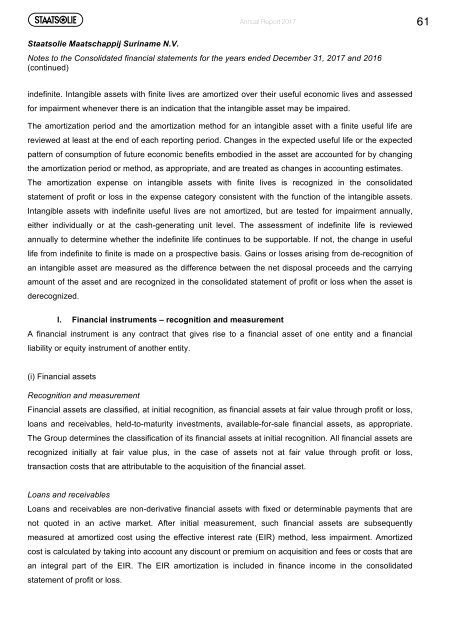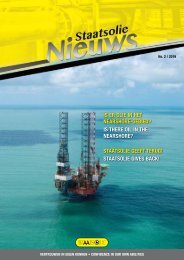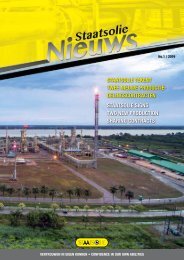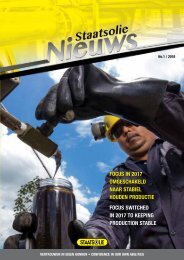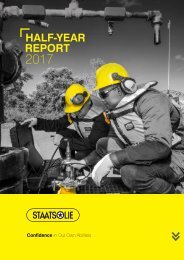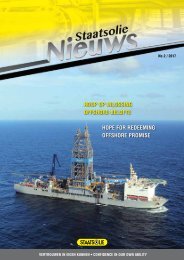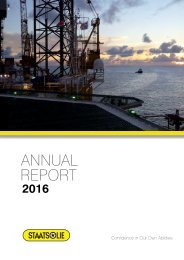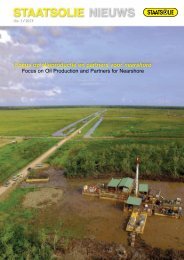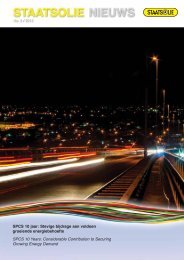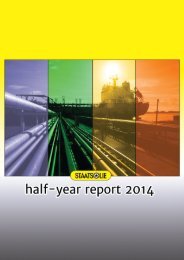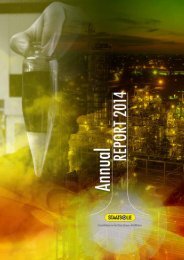Staatsolie Annual Report 2017
You also want an ePaper? Increase the reach of your titles
YUMPU automatically turns print PDFs into web optimized ePapers that Google loves.
<strong>Annual</strong> <strong>Report</strong> <strong>2017</strong> 61<br />
<strong>Staatsolie</strong> Maatschappij Suriname N.V.<br />
<strong>Staatsolie</strong> Maatschappij Suriname N.V.<br />
Notes to the Consolidated financial statements for the years ended December 31, <strong>2017</strong> and 2016<br />
Notes (continued) to the Consolidated financial statements for the years ended December 31, <strong>2017</strong> and 2016<br />
(continued)<br />
Inventories are stated at the lower of cost and net realizable value. Net realizable value is the estimated<br />
indefinite. Intangible assets with finite lives are amortized over their useful economic lives and assessed<br />
selling price in the ordinary course of business, less estimated costs of completion and the estimated<br />
for impairment whenever there is an indication that the intangible asset may be impaired.<br />
costs to sell.<br />
The amortization period and the amortization method for an intangible asset with a finite useful life are<br />
The cost of crude oil and refined products is the purchase cost, the cost of refining, including the<br />
reviewed at least at the end of each reporting period. Changes in the expected useful life or the expected<br />
appropriate proportion of depreciation, depletion and amortization and overheads based on normal<br />
pattern of consumption of future economic benefits embodied in the asset are accounted for by changing<br />
operating capacity, determined on a weighted average basis.<br />
the amortization period or method, as appropriate, and are treated as changes in accounting estimates.<br />
The net amortization realizable expense value of crude on intangible oil and refined assets products with finite is based lives on is the recognized estimated in selling the consolidated<br />
price in the<br />
statement ordinary course of profit business, or loss less the expense the estimated category costs consistent of completion with and the function the estimated of the costs intangible necessary assets. to<br />
Intangible make the sale. assets with indefinite useful lives are not amortized, but are tested for impairment annually,<br />
either individually or at the cash-generating unit level. The assessment of indefinite life is reviewed<br />
Materials and supplies are valued using the weighted average cost method.<br />
annually to determine whether the indefinite life continues to be supportable. If not, the change in useful<br />
life from indefinite to finite is made on a prospective basis. Gains or losses arising from de-recognition of<br />
Pipeline fill<br />
an intangible asset are measured as the difference between the net disposal proceeds and the carrying<br />
Crude oil, which is necessary to bring a pipeline into working order, is treated as a part of the related<br />
amount of the asset and are recognized in the consolidated statement of profit or loss when the asset is<br />
pipeline. This is on the basis that it is not held for sale or consumed in a production process, but is<br />
derecognized.<br />
necessary to the operation of a facility during more than one operating cycle, and its cost cannot be<br />
recouped through sale (or is significantly impaired). This applies even if the part of inventory that is<br />
l. Financial instruments – recognition and measurement<br />
deemed to be an item of property, plant and equipment cannot be separated physically from the rest of<br />
A financial instrument is any contract that gives rise to a financial asset of one entity and a financial<br />
inventory. It is valued at cost and is depreciated over the useful life of the related asset.<br />
liability or equity instrument of another entity.<br />
n. Impairment of non-financial assets<br />
(i) Financial assets<br />
The Group assesses at each reporting date whether there is an indication that an asset may be impaired.<br />
Recognition and measurement<br />
If any indication exists, or when annual impairment testing for an asset is required, the Group estimates<br />
Financial assets are classified, at initial recognition, as financial assets at fair value through profit or loss,<br />
the asset’s recoverable amount. An asset’s recoverable amount is the higher of an asset’s or cash<br />
loans and receivables, held-to-maturity investments, available-for-sale financial assets, as appropriate.<br />
generating units (CGU) fair value less costs of disposal and its value in use. It is determined for an<br />
The Group determines the classification of its financial assets at initial recognition. All financial assets are<br />
individual asset, unless the asset does not generate cash inflows that are largely independent of those<br />
recognized initially at fair value plus, in the case of assets not at fair value through profit or loss,<br />
from other assets or groups of assets. Where the carrying amount of an asset or CGU exceeds its<br />
transaction costs that are attributable to the acquisition of the financial asset.<br />
recoverable amount, the asset is considered impaired and is written down to its recoverable amount. In<br />
assessing value in use, the estimated future cash flows are discounted to their present value using a pretax<br />
discount rate that reflects current market assessments of the time value of money and the risks<br />
Loans and receivables<br />
Loans and receivables are non-derivative financial assets with fixed or determinable payments that are<br />
specific to the asset. In determining fair value less costs of disposal, recent market transactions are taken<br />
not quoted in an active market. After initial measurement, such financial assets are subsequently<br />
into account. If no such transactions can be identified, an appropriate valuation model is used.<br />
measured at amortized cost using the effective interest rate (EIR) method, less impairment. Amortized<br />
Impairment losses of continuing operations are recognized in the consolidated statement of profit or loss<br />
cost is calculated by taking into account any discount or premium on acquisition and fees or costs that are<br />
in those expense categories consistent with the function of the impaired asset, except for a property<br />
an integral part of the EIR. The EIR amortization is included in finance income in the consolidated<br />
previously revalued where the revaluation was taken to OCI. In this case, the impairment is also<br />
statement of profit or loss.<br />
recognized in OCI up to the amount of any previous revaluation.<br />
Page 63<br />
Page 61


